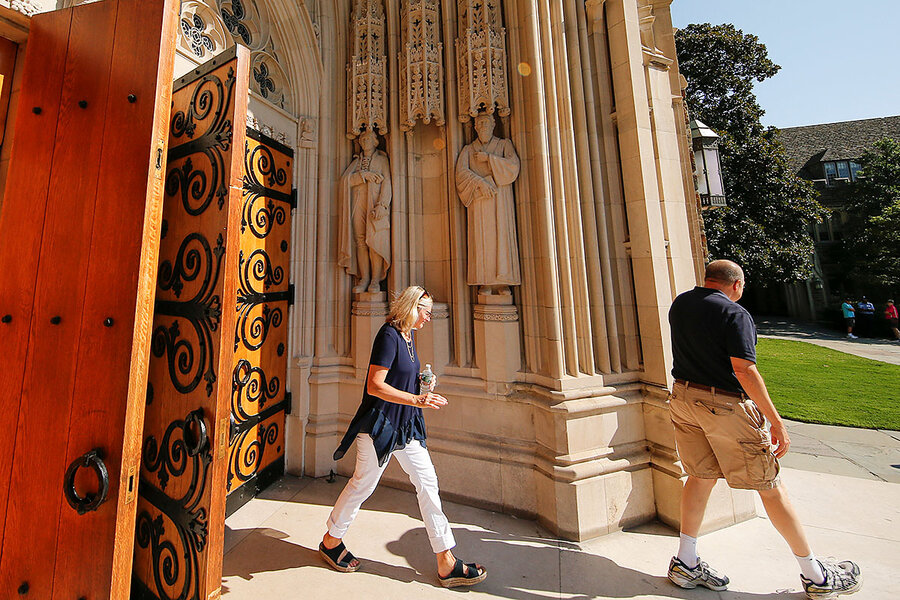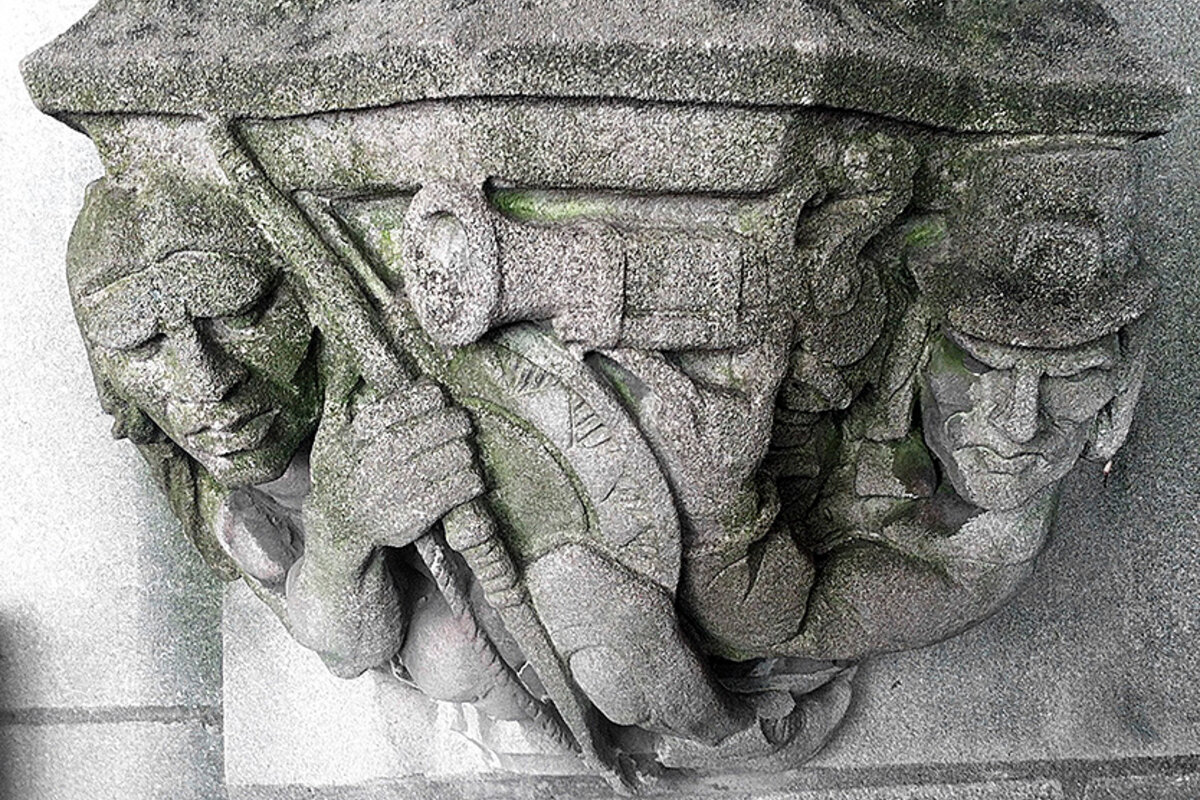Confederate monuments: What to do with them?
Loading...
| Baltimore, Md.
Clarissa Harriss hesitated at the spot where the statue of Robert E. Lee and Stonewall Jackson used to stand.
In 1948, as a little girl, Ms. Harriss had worn a polka-dot dress and carried yellow roses and participated in the statue’s dedication. She’d laid her flowers at the base of the stone representation of the famous Confederate generals. The mayor spoke. There were bands.
Today Harriss had returned with her dog and a new bouquet. She wanted to praise current Baltimore Mayor Catherine Pugh for hauling the statue away in the dead of night. In a majority-minority city, monuments to generals who fought for the South in the Civil War are controversial, to put it mildly. Better to eliminate the potential flash point, Harriss thought.
But she didn’t want anyone to think she was memorializing the gone statue. It was the absence she wanted to acknowledge. So she waited a moment, walking around the now-empty plinth. She decided the mood of the small gathered crowd was celebratory. She lay down her small bunch of roses – pink this time.
“They’re from my garden,” she said. “At least they’ve got a yellow ribbon.”
All across America, inanimate Confederate statues and memorials have come to life as a political issue. Whom do they represent? What is their message? After violence erupted between white supremacists and counter-protesters in Charlottesville over the city’s plan to remove a statue of Robert E. Lee, the nation is again confronting the legacy of its most divisive war.
The immediate question is deceptively simple – should they stay or should they go? In Baltimore – a city already battered by violence – the mayor preempted the discussion, and whisked four Confederate monuments away, out of public view. The University of Texas did the same.
In Charlottesville, the City Council on Monday approved covering statues in black fabric to mourn Heather Heyer, the counter-protester killed on Aug. 12. In Richmond, which served as the capital of the Confederacy during the Civil War, removal of the famous Confederate statues on the city’s Monument Avenue suddenly seems a real possibility.
Not everyone celebrates these moves. According to polls, many Americans agree with President Trump, who last week said on Twitter that the “history and culture of our great country” is being “ripped apart with the removal of our beautiful statues and monuments.”
But history is not static, like words in a dusty textbook. Our collective memory is shaped by what we have forgotten as well as what we have remembered. The changing status of Confederate statues may not be so much an erasure of the past as a shift in the aspects of the past that we emphasize, say historians.
That doesn’t mean all the statues have to be removed. It may mean that those who live with them should have more influence over their future.
“One of the possible outcomes of this contemporary debate is that there may be some communities that come up with very creative ways to engage the existing monuments,” says W. Fitzhugh Brundage, a professor of history at the University of North Carolina at Chapel Hill and an adviser to the Commemorative Landscapes of North Carolina project.
Today there are at least 700 Confederate monuments in the United States, though nobody really knows the exact number. Most – though not all – are in the South. Only a few have been taken down or become the subject of political controversy. The rest face an uncertain future.
The vast majority of the statues were not erected in the immediate aftermath of the Civil War. They date instead to the end of Reconstruction in the late 19th century or the period of the early 20th century when Southern political leaders were instituting segregationist Jim Crow laws.
Many weren’t funded by public money, or erected by process of public law. According to Prof. Brundage, typically private groups such as the United Daughters of the Confederacy paid for memorials, arranged for public space, and hosted dedications. The groups claimed to represent local opinion.
Baltimore’s Lee and Jackson statue was typical. J. Henry Ferguson, a wealthy local banker for whom Lee was a hero, largely funded its creation in the 1920s. It wasn’t dedicated until 1948 – after World War II, when the civil rights movement was beginning to stir.
As a piece of art, the statue is notable. It is one of the first double-equestrian statues in the United States, done by sculptor Laura Gardin Fraser. John Russell Pope, architect of the nearby Baltimore Museum of Art, designed its base.
Today the base is all that’s left. On the north side its inscription reads, referring to Lee and Jackson: “THEY WERE GREAT GENERALS AND CHRISTIAN SOLDIERS AND WAGED WAR LIKE GENTLEMEN.” This is a not a sentiment shared today by the predominantly liberal urban population of Baltimore, given that the pair were fighting to preserve slavery.
“White supremacy is really what these statues represent,” says Judith Giesberg, a professor of history at Villanova University in Pennsylvania and editor of the Journal of the Civil War Era.
Preemptive removal
Given the stories these statues tell today, the question is what to do with them.
Or rather the question is what to do with them, if anything. Recent national polling has supported Mr. Trump’s assertion that the statues are about Southern pride and history. A plurality of 48 percent of Americans disapproves of Charlottesville’s decision to eventually remove its Robert E. Lee memorial, according to a recent survey by The Economist and YouGov. Thirty percent said they approved the move.
The problem is where the memorials are. Many of the largest and most prominent are in cities, and even in red states, urban areas tend blue and liberal. That can produce political tension.
A number of states in the south, including North Carolina, Alabama, Virginia, and Mississippi, have passed laws banning cities from unilaterally moving memorials. In some places, aggrieved citizens have ignored these laws. Days after the Aug. 12 Charlottesville violence, protestors in Durham, N.C., toppled a large statue of a Confederate soldier outside a courthouse with ropes.
In Baltimore, Mayor Pugh was worried about similar vandalism, or demonstrations. That’s why she made the removal of the Lee/Jackson statue and three other monuments a surprise.
“I think these decisions have to be made at the local level. In majority-black cities these conversations have been going on for a long time,” says Dr. Giesberg.
Some cities have talked about adding context to Confederate memorials, such as plaques explaining their Jim Crow-related history. Richmond Mayor Levor Stoney has discussed this approach in the past.
The problem is that adding context is hard, says Brundage. There are only so many words you can cram on a plaque. Who will read it if they’re driving by? Meanwhile, the monument continues to occupy a privileged space.
“You’re going to have communities all over the South thinking, how do we do this?” he says.
What to do with removed statues
The first step should be a repeal of state laws banning the movement of Confederate statues, according to Brundage. Then communities should have their own meetings and referendums. They could vote to move them, to take them down, or to keep them. Some places might take on more.
The small town of Brandenburg, Ky., last year accepted a tall Confederate memorial from Louisville, for instance. Town leaders said at the time that their area had a rich Civil War history and they thought the monument should be preserved.
If removed, monuments should be carefully documented, or perhaps even gathered in monument parks, say historians. Parts of the old Soviet Union have established museums of Soviet iconography, gathering statues of Lenin and Stalin into new groupings to try and reflect history instead of USSR propaganda.
In Baltimore, city officials have talked about donating the Lee and Jackson memorial to Chancellorsville, Va. The statue depicts the pair’s last meeting, before Lee won a decisive victory in the 1863 Battle of Chancellorsville and Jackson was killed by friendly fire.
Meanwhile, the empty base of the Lee statue in Baltimore has become a new memorial of sorts. Located at an intersection of a working-class neighborhood of row houses, Johns Hopkins University, and wealthy North Baltimore mansions, it has drawn a steady crowd of diverse onlookers. Some leave candles and other tokens. A local artist placed a colorful papier-mâché figure of a defiant and pregnant slave woman at its foot, as if facing off with the absent Confederates. There’s been graffiti vandalism as well.
“If anything constructive can come out of this moment, that seems precisely the effect you’d want to have in opening up these public spaces again to the people who live there,” says Giesberg of Villanova.









